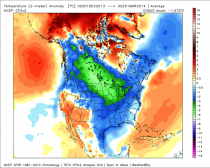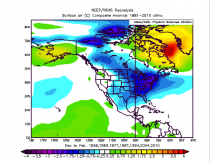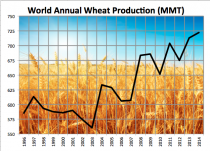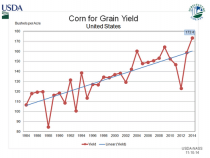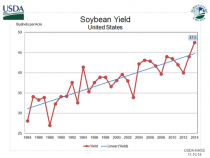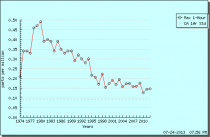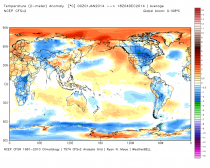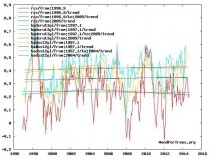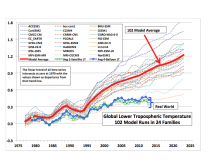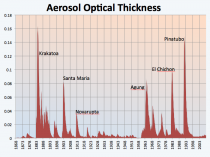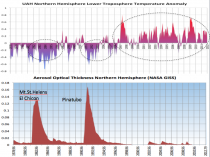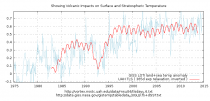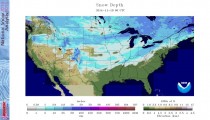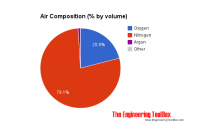The Deliberate Corruption of Climate Science by Dr. Tim Ball
-----------
By Craig Rucker
I have good news and bad news to report from yesterday’s meeting in West Virginia.
As I informed you earlier this week, the West Virginia Board of Education met on Wednesday to discuss proposed changes to the state’s K-12 science standards, changes that would actually allow debate on the issue of global warming.
First the good news. Because of the outpouring of response from friends like you to our request that you make your opinion known on this issue, we got word that we overwhelmed the system and caused it to crash! One board member even said at yesterday’s hearing he was amazed at the number of emails he received supporting the changes to the curriculum.
Without your input, only the alarmists would have been heard. You made sure that didn’t happen!
Also on the positive side, our CFACT Collegians made a huge impact on the tenor of the hearing and press coverage of the event. By organizing and bringing some of their peers from Marshall and West Virginia University, they proved to be the only young people to show up and speak out, and because of their passion and willingness to testify the Associated Press and local newspapers and TV networks couldn’t help but report that there was vocal support not just opposed to, but also in favor of, debate over climate change. I was never more proud of them!
CFACT’s Marc Morano also gave testimony, and made a huge media impact, garnering lots of press coverage and getting our message out on numerous networks.
You can see his coverage at ClimateDepot.com.
Unfortunately, there is also bad news to report. Because of pressure from the powerful, Politically Correct teachers’ establishment, the board ultimately wilted and voted to rescind the proposed changes. Rather than stand for scientific accuracy and encourage students to develop critical thinking, the board moved to return to the original language that allows for no questioning or debate on climate issues.
This was indeed a sad day for public education in West Virginia.
Now there are 30 days in which to comment on the new standards, and you can rest assured CFACT will be doing just that. Others, including state legislators and even some in Congress have indicated they were inspired by this showdown in the Mountain State and say they are now looking into what can be done.
Whether they act or not, only time will tell. But the long-term battle is far from over.
Again I want to thank you for your response to our call to action. The fight for free speech, fairness, and liberty is never easy, but we remain committed to the cause. In time, we ultimately will triumph.
For nature and people too,
Craig Rucker
Executive Director
P.S. Martha Boneta will be on Stossel on Fox Business Thursday January 15 at 9 PM (Eastern) to talk about her ongoing struggle to get the Greens and Virginia bureaucrats to respect her property rights at her beautiful Liberty Farm. Stossel usually repeats Sunday nights on Fox News.
----------
By Cory Toth
We need your help West Virginia school board scraps changes to NGSS
The group Achieve told the State Board of Education that if they did not follow word-by-word their standards on climate science, that they would kick WV out. The Board Members are not wanting to be removed as a member of Achieve as most other states are members and WV didn’t want to be the laughing stock of the education community.
The leader of Achieve is Michael Cohen. He can be reached at mcohen@achieve.org. To make matters worse the 41-person team who put together Achieve’s “science” standards.... None are from WV; none are climate scientists…
There is a 30 day comment period using the original standard. We need your help to provide comments! They have reversed the standards and went back to the original standards. Please see attachment which shows the standards revise..which have been vacated.
I want to point out there is a gentleman on our side of this issue. His name is Wade Linger and he is on the Board of Education. He is being out voted and being bullied by these outside organizations. He would like the help of you to submit comments, provide him with information, etc… His email is wade@linger.com
Please feel free to share with your fellow colleagues to have them weigh in as well.
Thanks,
Cory
The West Virginia Board of Education voted today to scrap changes it had made to the Next Generation Science Standards to inject more doubt about global warming. The board will next consider adopting the original standards - but first, it[s opened them up for public comment, the Charleston Gazette reports.
An advocacy group called West Virginia Climate Parents, which opposed the board’s tweaks to the NGSS, presented the board with 3,500 signatures demanding a return to the original document. Members praised today’s vote and said they would keep pressure on the board to adopt the standards next month without revisions.
“Ensuring students are taught evidence-based facts in their science education is a fundamental principle that the board affirmed today, after veering off course in December in adopting altered climate science standards,” said Lisa Hoyos, director of Climate Parents. Stephanie Simon
President Obama makes it clear that the only “common ground” he respects is his liberal turf
By Paul Driessen
New Republican members were still being sworn in and expressing their desire for bipartisan initiatives, when President Obama said he would veto the Keystone pipeline, ObamaCare fixes and other bills that run counter to his agenda. Washington’s new “common ground” will be a tricky, dangerous swamp.
Meanwhile, U.S. crude oil prices are below $50 per barrel, for the first time since 2009, and natural gas has dropped below $3 per million Btu (or thousand cubic feet). That’s bad news for Iran, Russia, Venezuela and ISIS, but great news for energy users. Motorists will save billions of dollars in gasoline costs; families, factories, hospitals, schools and malls will save billions on heating and electricity bills; and industries that are energy-intensive or use hydrocarbons as raw materials will reap huge benefits.
However, drilling and oilfield service companies are being squeezed by high production rates, low prices and excessive loans; some overcapitalized companies may go bankrupt. Slow global economic growth is reducing demand for American goods and services, and investors are pulling out of “emerging markets.”
Thankfully, most fracking companies are agile and creative. Their technological innovations have driven completion and production costs steadily downward, allowing them to produce oil, gas liquids and natural gas (methane) from many formations at costs low enough to make a profit even at today’s prices (or lower). When demand picks up and prices again rise, companies can drill and frack new wells or reopen old ones in shale regions within mere weeks, to meet increasing energy needs.
But now EPA is proposing new rules for conventional and fracked wells. The White House claims the rules are needed to reduce emissions of methane, which it calls a “potent greenhouse gas” that contributes to “dangerous climate change.” The real goal is to put federal bureaucrats in charge of fracking and production on state and private lands, now that they have made most federal lands off limits to drilling.
The proposed rulemaking ignores reality. Total U.S. methane emissions have already plunged 11% since 1990, and companies constantly implement technologies and procedures to reduce emissions of valuable natural gas from wells and pipelines. That has caused emissions related to drilling and transportation to plummet, even as natural gas drilling, fracking, production, pipelining and use have skyrocketed.
Mr. Obama’s fossil fuel obstructionism will further harm blue-collar families. His own State Department concluded that the Keystone XL pipeline project alone would create 50,000 jobs: 10,000 in construction; 16,000 providing pipe, valves, heavy equipment, hotel rooms and other goods and services directly related to the project; and 26,000 “indirect” jobs supported by primary and secondary workers spending their KXL wages in other sectors of the economy. Some 70% of Americans support building it.
These jobs may only be what the President derisively calls “temporary.” But that is the nature of all such jobs. You just need a steady stream of new projects to keep construction and factory workers employed for decades - versus the “permanent’ jobs the President seems to prefer: for bureaucrats who stifle other job creation or decree that only “renewable energy” jobs merit creation via taxpayer or borrowed money.
Blocking Keystone will also increase shipments of U.S. and Canadian oil via RR cars owned by Mr. Obama’s friend, Warren Buffet. That could mean more rail accidents and deaths. Proposed rules for retrofitting rail tankers for crash and puncture resistance will take years to implement, forcing oil to be shipped in trucks on our crowded highways in the meantime. Congress needs to approve Keystone.
The President may now favor allowing some processed U.S. oil to be exported. But his agencies are preparing numerous new rules that will undermine bipartisan energy, job and economic growth initiatives. The Competitive Enterprise Institute says they are considering 2,375 new rules this year - on top of 3,541 regulations approved in 2014. The total price tag for complying with federal rules: $1.9 trillion per year!
EPA has delayed its latest climate change regulations until summer, but they will likely require that coal-fueled power plants slash carbon dioxide emissions by 30% or close down. Since no affordable or proven technology exists to achieve this, the rule will shutter numerous power plants and cost some 600,000 jobs in states that rely on coal for reliable, affordable electricity. Moreover, as my Climate Hype Exposed report makes clear, the rules will do absolutely nothing to “stabilize” Earth’s always fickle climate.
President Obama’s determination to lock the United States and other countries into a binding new climate change treaty will magnify the damage many times over. First, developing nations like China and India must merely agree to try at some future date to make some efforts to reduce their greenhouse gas emissions. Other countries can walk away from treaty obligations that become too burdensome. That will penalize the United States as almost the only nation required to abide by its suicidal climate agreements.
Second, few (formerly) rich countries will ever honor their supposed commitments to provide billions of dollars a year for climate change “adaptation” and “mitigation” - and those contributions will never come anywhere near the $100 billion per year that poor developing countries are demanding as their price for signing a treaty. Third, most of this money will end up in Swiss bank accounts of kleptocratic African, UN and other dictators, bureaucrats, politicians, activists and corporatists. The poor will get nothing.
Fourth, most of this promised aid - as well as OPIC, World Bank and other loans and grants - comes with the proviso that the money be used only for wind, solar and biofuel projects. Poor countries will be prevented from building coal or gas power plants to lift billions out of poverty via reliable, affordable electricity. Billions of people will remain trapped in poverty, misery, disease and early death - with improved education, healthcare, jobs, food, clean water and sanitation remaining largely out of reach.
What can the new Republican Congress do in the face of the President’s ideological intransigence?
* Pass Keystone pipeline legislation and bills promoting expanded leasing and drilling on federal lands.
* End abuses detailed in the Senate Staff Report, Chains of Environmental Command, and other studies that reveal how Big Green colludes with federal agencies to impose job-killing policies and regulations. Hold hearings and question agency heads under oath. Root out collusion between agencies and activists, sweetheart sue-and-settle lawsuits, and other agency misconduct, deceit and fraud in devising regulations. Apply the same ethics and integrity rules to them that they impose on us.
* Employ budget reductions, budget restrictions and specific legislative language to: block regulations that do not pass Information Quality Act standards of transparency, integrity and scientific analysis; end payoffs to advisory panels and pressure groups; and prohibit EPA from expanding its mission and personnel by launching sustainable development, “environmental justice” and climate programs.
* Require that EPA and other agencies fully and honestly assess the potentially harmful effects that their regulations are likely to have on jobs and human health and well-being - and subject proposed rulemakings to review by industry and other independent outside experts - before rules can be implemented. Alleged benefits of rules must clearly exceed their monetary, job, health and welfare costs.
* Require congressional approval of any “major” regulatory actions likely to cost $100 million or more - and periodic assessments of the cumulative costs of all federal regulations.
* Prohibit the Executive Branch from spending taxpayer funds on climate change “adaptation/mitigation” payments to developing countries, until all other countries make binding pledges and we have proof of manmade climate change. Ban requirements that grants be used solely for renewable energy projects.
* Use vetoes and Democratic obstinacy to underscore the need for more pro-growth and environmental-balance candidates in 2016 congressional and presidential elections - by showing leadership and responsible alternatives to eight years of Reid, Pelosi and Obama obstruction and job destruction.
State governors, legislatures, courts and AGs should do likewise - and voters should demand nothing less.
Paul Driessen is senior policy analyst for the Committee For A Constructive Tomorrow (http://www.CFACT.org) and author of Eco-Imperialism: Green power - Black death.
James Taylor, Forbes
Environmentalists delivered a dire report this Christmas season: Human-caused global warming is causing wheat harvests to fall. The message was repeated uncritically by much of the mainstream media.
Had they bothered to check the facts, the media would have discovered climate alarmists were lying once again. Wheat yields are rising dramatically in the U.S. and internationally - due in part, no doubt, to the fertilizing effect of increasing atmospheric carbon dioxide concentrations.
In his regular column at Forbes.com, James M. Taylor - a senior fellow of The Heartland Institute, which distributes Climate Change Weekly - refutes alarmists’ claims concerning wheat production by going directly to the data. The U.S. Department of Agriculture reports global wheat yields have risen by 33 percent since 1994. In addition, there has been a 4 percent increase in land acreage growing wheat. Combined, the 33 percent increase in per-acre wheat yield and the 4 percent increase in land harvested for wheat equal an almost 40 percent increase in the global wheat harvest since 1994. Rather than slowing, yields set records in 2013 and again in 2014.

Global wheat production sets new records virtually every year, contradicting alarmist’ claims of falling production.
Alarmists and media lied both about general wheat trends and wheat production in specific countries and continents. For instance, Reuters cited a single report to claim wheat yields had fallen in hotter regions such as in Africa, Australia, Brazil, and India. The real data, highlighted by Taylor, tell a quite different story:
Wheat production in Egypt, the only significant producer of wheat in Africa, has quadrupled during the past 30 years, “with the past 10 years producing the 10 highest wheat crops in Egyptian history.”
In addition, “Africa’s second largest wheat producing country, Morocco, produced its highest wheat crop in history in 2013,” and South Africa produced record wheat yields in 2014.
Brazil also produced consecutive years of record wheat yields in 2013 and 2014, 2014’s wheat crop being 30 percent larger than 2013’s record yield.
India appears likely in 2014 to surpass its previous wheat production record, set in 2012.
Of the countries cited by Reuters as having falling wheat production, only Australia failed to produce a record crop in 2013 or 2014. However, as Taylor points out, “its 2014 wheat crop was the eighth largest in its history,” with the record yield set just three years ago in 2011. Australia’s wheat production has risen steadily for four decades, with 2014’s wheat crop being four times larger than the yield in 1972.
For far too long, environmentalists and their willing dupes in the media have been allowed to make false claims unchallenged. Once the facts are checked, global warming-related food fears should fade, like darkness before the light of day.
See the world wheat record and the US corn and soybean record yields.
Merry Christmas, a belated Happy Hanukkah and Happy New Year!
Google’s fleet of electricity-gobbling servers makes it a hugely energy-intensive company. Its success underscores the quality of its corporate leadership. However, Chairman Eric Schmidt and his top engineers display limited knowledge and poor leadership when it comes to climate change and electricity generation. Mr. Schmidt insists that “Everyone understands climate change is occurring, and the people who oppose it are really hurting our children and our grandchildren.” His engineers replay scary claims by former NASA astronomer James Hansen that exceeding 350 parts per million of atmospheric carbon dioxide “would likely have catastrophic effects.”
Our article highlights the major errors in these claims, and explains how the scientific method clearly demonstrates the absence of evidence to support fear mongering about “catastrophic manmade climate change.”
Thank you for posting the article, quoting from it, and forwarding it to your friends and colleagues. (Please be sure to credit Chris as coauthor of this article.)
Best regards,
Paul
Chairman Eric Schmidt should heed his own advice and base energy policies on facts
Paul Driessen and Chris Skates
In a recent interview with National Public Radio host Diane Rehm, Google Chairman Eric Schmidt said his company “has a very strong view that we should make decisions in politics based on facts. And the facts of climate change are not in question anymore. Everyone understands climate change is occurring, and the people who oppose it are really hurting our children and our grandchildren and making the world a much worse place. We should not be aligned with such people. They’re just literally lying.”
While he didn’t vilify us by name, Mr. Schmidt was certainly targeting us, the climate scientists who collect and summarize thousands of articles for the NIPCC’s Climate Change Reconsidered reports, the hundreds who participate in Heartland Institute climate conferences, and the 31,487 US scientists who have signed the Oregon Petition, attesting that there is no convincing scientific evidence that humans are causing catastrophic warming or climate disruption.
All of us are firm skeptics of claims that humans are causing catastrophic global warming and climate change. We are not climate change “deniers.” We know Earth’s climate and weather are constantly in flux, undergoing recurrent fluctuations that range from flood and drought cycles to periods of low or intense hurricane and tornado activity, to the Medieval Warm Period (950-1250 AD) and Little Ice Age (1350-1850) - and even to Pleistocene glaciers that repeatedly buried continents under a mile of ice.
What we deny is the notion that humans can prevent these fluctuations, by ending fossil fuel use and emissions of plant-fertilizing carbon dioxide, which plays only an insignificant role in climate change.
The real deniers are people who think our climate was and should remain static and unchanging, such as 1900-1970, supposedly, during which time Earth actually warmed and then cooled, endured the Dust Bowl, and experienced periods of devastating hurricanes and tornadoes.
The real deniers refuse to recognize that natural forces dictate weather and climate events. They deny that computer model predictions are completely at odds with real world events, that there has been no warming since 1995, and that several recent winters have been among the coldest in centuries in the United Kingdom and continental Europe, despite steadily rising CO2 levels. They refuse to acknowledge that, as of December 25, it’s been 3,347 days since a Category 3-5 hurricane hit the US mainland; this is by far the longest such stretch since record-keeping began in 1900, if not since the American Civil War.
Worst of all, they deny that their “solutions” hurt our children and grandchildren, by driving up energy prices, threatening electricity reliability, thwarting job creation, and limiting economic growth in poor nations to what can be sustained via expensive wind, solar, biofuel and geothermal energy. Google’s corporate motto is “Don’t be evil.” From our perspective, perpetuating poverty, misery, disease and premature death in poor African and Asian countries - in the name or preventing climate change - is evil.
It is truly disturbing that Mr. Schmidt could make a statement so thoroughly flawed in its basic premise. He runs a multi-billion dollar company that uses vast quantities of electricity to disseminate information throughout the world. Perhaps he should speak out on issues he actually understands. Perhaps he would be willing to debate us or Roy Spencer, David Legates, Pat Michaels and other climate experts.
Setting aside the irrational loyalty of alarmists like Schmidt to a failed “dangerous manmade climate change” hypothesis, equally disturbing is the money wasted because of it. Consider an article written for the Institute of Electric and Electronic Engineers’ summit website by Google engineers Ross Koningstein and David Fork, who worked on Google’s “RE
Beginning in 2007, they say, "Google committed significant resources to tackle the world's climate and energy problems. A few of these efforts proved very successful: Google deployed some of the most energy efficient data centers in the world, purchased large amounts of renewable energy, and offset what remained of its carbon footprint."
It's wonderful that Google improved the energy efficiency of its power-hungry data centers. But the project spent countless dollars and man hours. To what other actual benefits? To address precisely what climate and energy problems? And how exactly did Google offset its carbon footprint? By buying "carbon credits" from outfits like the New Forests Company, which drove impoverished Ugandan villagers out of their homes, set fire to their houses and burned a young boy to death?
What if, as skeptics like us posit and actual evidence reflects, man-made climate change is not in fact occurring? That would mean there is no threat to humans or our planet, and lowering Google's CO2 footprint would bring no benefits. In fact, it would keep poor nations poverty stricken and deprived of modern technologies - and thus unable to adapt to climate change. Imagine what Google could have accomplished if its resources had been channeled to solving actual problems with actual solutions!
In 2011, the company decided its REC project would not meet its goals. Google shut it down. In their article, Koningstein and Fork admit that the real result of all of their costly research was to reach the following conclusion: “green energy is simply not economically, viable and resources that we as a society waste in trying to make it so would be better used to improve the efficiencies in established energy technologies like coal.”
Skeptics like us reached that conclusion long ago. It is the primary reason for our impassioned pleas that that the United States and other developed nations stop making energy policy decisions based on the flawed climate change hypothesis. However, the article’s most breathtaking statement was this:
“Climate scientists have definitively shown that the buildup of carbon dioxide in the atmosphere poses a looming danger,,, A 2008 paper by James Hansen, former director of NASA’s Goddard Institute for Space Studies… showed the true gravity of the situation. In it, Hansen set out to determine what level of atmospheric CO2 society should aim for ‘if humanity wishes to preserve a planet similar to that on which civilization developed and to which life on Earth is adapted.’ His climate models showed that exceeding 350 parts per million CO2 in the atmosphere would likely have catastrophic effects. We’\’ve already blown past that limit. Right now, environmental monitoring shows concentrations around 400 ppm”.
We would never presume to question the sincerity, intellect, dedication or talent of these two authors. However, this statement presents a stunning failure in applying Aristotelian logic. Even a quick reading would make the following logical conclusions instantly obvious:
1. Hansen theorized that 350 ppm of atmospheric CO2 would have catastrophic results.
2. CO2 did indeed reach this level, and then exceeded it by a significant amount.
3. There were no consequences, much less catastrophic results, as our earlier points make clear.
4. Therefore, real-world evidence clearly demonstrates that Hansen’s hypothesis is wrong.
This kind of reasoning (the scientific method) has served progress and civilization well since the Seventeenth Century. But the Google team has failed to apply it; instead it repeats the “slash fossil fuel use or Earth and humanity are doomed” tautology, without regard for logic or facts - while questioning CAGW skeptics intelligence, character and ethics. Such an approach would be disastrous in business.
We enthusiastically support Eric Schmidt’s admonition that our nation base its policy decisions on facts, even when those facts do not support an apocalyptic environmental worldview. We also support President Obama’s advice that people should not “engage in self-censorship,” because of bullying or “because they don’t want to offend the sensibilities of someone whose sensibilities probably need to be offended.”
In fact, we will keep speaking out, regardless of what Messsrs. Schmidt, Hansen and Obama might say.
_______
Paul Driessen is senior policy analyst for the Committee For A Constructive Tomorrow (http://www.CFACT.org), author of Eco-Imperialism: Green power Black death and coauthor of Cracking Big Green: To save the world from the save-the-earth money machine. Chris Skates is an environmental chemist and author of Going Green: For some it has nothing to do with the environment.
Guest Post by Willis Eschenbach, WUWT
Thanks to the blog of the irrepressible Hilary Ostrov, a long-time WUWT commenter, I found out about a poll gone either horribly wrong or totally predictably depending on your point of view. It’s a global poll done by the United Nations, with over six million responses from all over the planet, and guess what?
The revealed truth is that of the sixteen choices given to people regarding what they think are the important issues in their lives, climate change is dead last. Not only that, but in every sub-category, by age, by sex, by education, by country grouping, it’s right down at the bottom of the list. NOBODY thinks it’s important.
Now, people are always saying how the US is some kind of outlier in this regard, because polls in the US always put climate change down at the bottom, whereas polls in Europe generally rate it somewhat higher. But this is a global poll, with people chiming in from all over the planet. The top fifteen countries, in order of the number of people voting, were Mexico, Nigeria, India, Pakistan, Sri Lanka, Yemen, Philippines, Thailand, Cameroon, United States, Ghana, Rwanda, Brazil, Jordan, and Morocco ...so this appears to be truly representative of the world, which is mostly non-industrialized nations.
So the next time someone tries to claim that climate change is “the most important challenge facing the world”....point them to the website of the study, and gently inform them that the rest of the world doesn’t buy that kind of alarmist hogwash for one minute. People are not as stupid as their leaders think, folks know what’s important and what’s trivial in their lives, and trying to control the climate is definitely in the latter group.
The poll will be open until 2015, so you can register your own priorities…
My regards to everyone, I’m off for a staff Christmas dinner with the workmates of the gorgeous ex-fiancee, life is good.
w.
----------
EPA Proposes Potentially Costly New Ozone Regulations
Strict new ozone standards announced by the Environmental Protection Agency (EPA) could be the most expensive regulation ever imposed on the American public. The current standard of 75 parts per billion (ppb)—the most stringent ever enacted when it was issued in 2008 - hasn’t been fully implemented yet. Even so, air quality has improved dramatically over the past decades and will continue to improve as EPA and states implement existing standards.
EPA’s move to set standards between 65 and 70 parts per billion, and to take comments on standards as low as 60 ppb, is not supported by science. A current review of health studies shows no compelling evidence that more stringent standards are needed when the current standards already protect public health.
The cost to the economy, jobs and consumers could be significant. A recent study from NERA Economic Consulting commissioned by the National Association of Manufacturers (NAM) shows that further tightening ozone standards to the lowest level EPA is considering could result in:
A loss of $3.4 trillion in U.S. GDP from 2017 to 2040
2.9 million fewer job equivalents per year on average through 2040
Increased natural gas and electricity costs for businesses and families across the country
Standards that would impose unachievable emission reduction requirements on virtually every part of the nation are clearly a misguided overreach. Even pristine areas with no industrial activity such as national parks could be out of attainment. Operating under such stringent requirements could stifle new investments necessary to create jobs and grow our economy. The right policy choice is to implement the current standards and allow air quality to continue to improve.
Scientists are human and have their opinions. Although we may like to think of science as a purely objective search after truth, we have to be realistic. It would be all but impossible for a researcher to start an experiment without having some idea about the expected outcome. Objectivity then comes in the form of a willingness to accept evidence which points to a different answer. Nevertheless, in most cases there is likely to be a tendency towards confirmation bias: giving more weight to observations which conform to your expectations or opinions.
A well-known example of this is the determination of the charge on an electron, famously first measured in the Millikan oil-drop experiment just over a hundred years ago. This balanced the gravitational pull on tiny oil drops by an applied electric field. Millikan arrived at a value (to five significant figures) which was very close to the accepted present-day value, but it turned out he had the wrong value for one of the factors in the equation. The ever-insightful and quotable Richard Feynman spoke about this in his 1974 commencement address at Caltech (’cargo cult science’ “...Millikan measured the charge on an electron by an experiment with falling oil drops, and got an answer which we now know not to be quite right. It’s a little bit off because he had the incorrect value for the viscosity of air. It’s interesting to look at the history of measurements of the charge of an electron, after Millikan. If you plot them as a function of time, you find that one is a little bit bigger than Millikan’s, and the next one’s a little bit bigger than that, and the next one’s a little bit bigger than that, until finally they settle down to a number which is higher.
Why didn’t they discover the new number was higher right away? It’s a thing that scientists are ashamed of - this history - because it’s apparent that people did things like this: When they got a number that was too high above Millikan’s, they thought something must be wrong- and they would look for and find a reason why something might be wrong. When they got a number close to Millikan’s value they didn’t look so hard. And so they eliminated the numbers that were too far off...”.
That is one form of human behaviour we can probably do little about. But there comes a point beyond which science itself is misused and compromised. Rather than having evidence-based policymaking, we end up with policy-based evidence picking. A good (or, should I say, bad) example appeared in the Times this week. The headline says it all: Scientists accused of plotting to get pesticides banned.
The fuss is over the (currently temporary) EU ban on neonicotinoid insecticides over allegations that they are at least partly to blame for recent declines in the population of bees. Environmentalist groups had been campaigning against this class of compounds for many years, despite little evidence of any connection under real life conditions. What tipped the balance was a report from the Task Force on Systemic Pesticides, an advisory group to the International Union for Conservation of Nature, which reported on recent scientific work and called on regulators to “start planning for a global phase-out” of these insecticides.
However, the chairman of the Task Force, Maarten Bijleveld van Lexmond, and chairman of the IUCN, Piet Wit, were both at a meeting in Switzerland in June 2010 at which, according to a note leaked to the Times “...scientists agreed to select authors to produce four papers and co-ordinate their publication to ‘obtain the necessary policy change, to have these pesticides banned’. A paper by a ‘carefully selected first author’ would set out the impact of the pesticides on insects and birds ‘as convincingly as possible’. A second ‘policy forum’ paper would draw on the first to call for a ban..."If we are successful in getting these two papers published, there will be enormous impact, and a campaign led by WWF etc. It will be much harder for politicians to ignore a research paper and a policy forum paper in [a major scientific journal].’”
This smacks of environmental activism rather than objective science, despite the protestations of the Task Force chairman, “...a founding member of WWF in the Netherlands, that the Task Force was independent and unbiased.”
It seems that only scientists outside government and industry are to be regarded as independent. Self-selected bodies such as WWF are inevitably groups of like-minded people and seemingly intolerant of any dissent. Contrast this particular case, in which ‘independent’ activist scientists protest their innocence (and attract little public criticism, unfortunately) with the campaign against the European Commission’s soon-to-be ex-chief scientist, Professor Anne Glover (Chief scientist is forced out after green campaign).
Professor Glover was found guilty of holding the ‘wrong’ opinions about GM crops. The same Stalinist intolerance has also been used to keep the management board of the European Food Safety Authority free of anyone who did not conform to the ‘independent’ template. Professional scientists should be prepared to listen to conflicting views, if based on hard evidence, and not simply suppress them.
In a different area, we are now being told that World on course for warmest year, with plenty of talk of supposed increases in the incidence of extreme weather. Now, it may turn out that average temperatures in 2014 will be fractionally up on the previous high, but it is equally true to say that there has been no trend in either direction since 1998. The latest stories, put out to coincide with the current climate change talks in Lima (COP20), are designed to put pressure on negotiators to make progress towards a binding international agreement on emissions reduction at the pivotal Paris conference in a year’s time. The selection of one of the statements about temperature over the other is a clear form of confirmation bias.
While we expect scientists to be human, we should also expect them to remain grounded in scientific principles and be prepared to question their beliefs if the evidence contradicts them. To do otherwise is to compromise the integrity of the scientific community, the very characteristic which makes scientists among the most trusted groups in society.
Note here is the actual year to data anomalies based oon the 4 times a day initialization that goes into the forecast models. No adjustments like homogenization are made. Does that look like the warmest year ever to you. Note the 90N and 90S is actually a point but is stretched in this projection to the same distance as the circumference at the equator. In other words it exaggerates the areal coverage of any high latitude warmth. Note the global mean compared to the 1979 to 2010 climatology is just +1.08C.
Sateliites show it is not a record year - see and see here Lord Monckton’s update showing using RSS satellite date that the pause has reached 18 years 2 months.
The pause is now widely accepted and the climate models are failing.
So they have come up with 66 reasons to date as to why the models are failing instead of that they have given greenhouse gases credit for controlling climate when natural factors are the real drivers.
The latest is that small volcanoes are acting collectively to produce a veil of sulfate aerosols to block radiation. Of course is is well known that the number of global volcanoe remains about the same. Ash and sulfat aerosols from small volcanoes gets precipitated out in a few weeks. The big volcanoes that shoot to 80,000 to 120,000 feet of higher are the climate driver events. In the stable high atmosphere the aerosols spread around the globe and have a lifetime of a few years instead of a few weeks.
See how the big eruptions of Pinatubo and El Chichon cooled the globe by up to 0.5C for several years. If anything the lack of volcanoes may have contributed to the warming after 1995 when the volcanic efects diminished.
When I did a correlation with temperatues in years with aerosol levels more 0.5 STD above normal and 0.5 STD below normal, I found the expected ressult of cooling when the aerosols were high and warming when low.
Here is Anthony Watts post on the paper subjecting the small eruoption may be responsible for failed models.
Small volcanic eruptions could be slowing global warming
From the AGU: WASHINGTON, DC
Small volcanic eruptions might eject more of an atmosphere-cooling gas into Earth’s upper atmosphere than previously thought, potentially contributing to the recent slowdown in global warming, according to a new study.
Scientists have long known that volcanoes can cool the atmosphere, mainly by means of sulfur dioxide gas that eruptions expel. Droplets of sulfuric acid that form when the gas combines with oxygen in the upper atmosphere can remain for many months, reflecting sunlight away from Earth and lowering temperatures. However, previous research had suggested that relatively minor eruptions those in the lower half of a scale used to rate volcano “explosivity” do not contribute much to this cooling phenomenon.
Now, new ground, air and satellite measurements show that small volcanic eruptions that occurred between 2000 and 2013 have deflected almost double the amount of solar radiation previously estimated. By knocking incoming solar energy back out into space, sulfuric acid particles from these recent eruptions could be responsible for decreasing global temperatures by 0.05 to 0.12 degrees Celsius (0.09 to 0.22 degrees Fahrenheit) since 2000, according to the new study accepted to Geophysical Research Letters, a journal of the American Geophysical Union.
These new data could help to explain why increases in global temperatures have slowed over the past 15 years, a period dubbed the ‘global warming hiatus,’ according to the study’s authors.
The warmest year on record is 1998. After that, the steep climb in global temperatures observed over the 20th century appeared to level off. Scientists previously suggested that weak solar activity or heat uptake by the oceans could be responsible for this lull in temperature increases, but only recently have they thought minor volcanic eruptions might be a factor.
Climate projections typically don’t include the effect of volcanic eruptions, as these events are nearly impossible to predict, according to Alan Robock, a climatologist at Rutgers University in New Brunswick, N.J., who was not involved in the study. Only large eruptions on the scale of the cataclysmic 1991 Mount Pinatubo eruption in the Philippines, which ejected an estimated 20 million metric tons (44 billion pounds) of sulfur, were thought to impact global climate. But according to David Ridley, an atmospheric scientist at the Massachusetts Institute of Technology in Cambridge and lead author of the new study, classic climate models weren’t adding up.
“The prediction of global temperature from the [latest] models indicated continuing strong warming post-2000, when in reality the rate of warming has slowed,” said Ridley. That meant to him that a piece of the puzzle was missing, and he found it at the intersection of two atmospheric layers, the stratosphere and the troposphere- the lowest layer of the atmosphere, where all weather takes place. Those layers meet between 10 and 15 kilometers (six to nine miles) above the Earth.
Traditionally, scientists have used satellites to measure sulfuric acid droplets and other fine, suspended particles, or aerosols, that erupting volcanoes spew into the stratosphere. But ordinary water-vapor clouds in the troposphere can foil data collection below 15 km, Ridley said. :The satellite data does a great job of monitoring the particles above 15 km, which is fine in the tropics. However, towards the poles we are missing more and more of the particles residing in the lower stratosphere that can reach down to 10 km.”
To get around this, the new study combined observations from ground-, air- and space-based instruments to better observe aerosols in the lower portion of the stratosphere.
Four lidar systems measured laser light bouncing off aerosols to estimate the particles’ stratospheric concentrations, while a balloon-borne particle counter and satellite datasets provided cross-checks on the lidar measurements. A global network of ground-based sun-photometers, called AERONET, also detected aerosols by measuring the intensity of sunlight reaching the instruments. Together, these observing systems provided a more complete picture of the total amount of aerosols in the stratosphere, according to the study authors.
Including these new observations in a simple climate model, the researchers found that volcanic eruptions reduced the incoming solar power by - 0.19 plus/minus 0.09 watts of sunlight per square meter of the Earth’s surface during the ‘global warming hiatus’, enough to lower global surface temperatures by 0.05 to 0.12 degrees Celsius (0.09 to 0.22 degrees Fahrenheit). By contrast, other studies have shown that the 1991 Mount Pinatubo eruption warded off about three to five watts per square meter at its peak, but tapered off to background levels in the years following the eruption. The shading from Pinatubo corresponded to a global temperature drop of 0.5 degrees Celsius (0.9 degrees Fahrenheit).
Robock said the new research provides evidence that there may be more aerosols in the atmosphere than previously thought. “This is part of the story about what has been driving climate change for the past 15 years,” he said. “It’s the best analysis we’ve had of the effects of a lot of small volcanic eruptions on climate.”
Ridley said he hopes the new data will make their way into climate models and help explain some of the inconsistencies that climate scientists have noted between the models and what is being observed.
Robock cautioned, however, that the ground-based AERONET instruments that the researchers used were developed to measure aerosols in the troposphere, not the stratosphere. To build the best climate models, he said, a more robust monitoring system for stratospheric aerosols will need to be developed.
Greg Goodman’s comments on WUWT make more sense.
No, this counter-intuitive volcano argument has already been tried. Excuse no. 8 IIRC
I already commented on this today in Willis’ thread.
The haitus is caused by the LACK of volcanoes because it was the volcanoes that caused the late 20th warming in the first place.
Stratospheric cooling :
Surface warming:
The sulphuric acid reacts not just “oxygen” O2 but ozone : O3. Ozone blocks UV , so less UV is one cause of warming. Sorry UN, none of this has to do with CFCs the Montreal protocol as can be seem from first plot. CFCs have not been bouncing up and down in time with major volacanic eruptions.
There’s more than just the ozone, but if they want to talk about ozone it’s in the stratosphere where it counts, not at 15km.
At least they working with real data but the claimed excuse for the pause is just more maybe, could-be pseudo-science.
Focusing on carbon dioxide (because that’s where the money is) threatens forecasts, and lives PDF
Paul Driessen and David R. Legates
President Obama’s agreement with China is about as credible as his “affordable care” pronouncements.
Pleistocene glaciers repeatedly buried almost half of the Northern Hemisphere under a mile of ice. The Medieval Warm Period (~950-1250 AD) enriched agriculture and civilizations across Asia and Europe, while the Little Ice Age that followed (~1350-1850) brought widespread famines and disasters. The Dust Bowl upended lives and livelihoods for millions of Americans, while decades-long droughts vanquished once-thriving Anasazi and Mayan cultures, and flood and drought cycles repeatedly pounded African, Asian and Australian communities. Hurricanes and tornadoes have also battered states and countries throughout history, in numbers and intensities that have been impossible to pattern or predict.
But today we are supposed to believe climate variability is due to humans - and computer models can now forecast climate changes with amazing accuracy. These models and the alarmist scientists behind them say greenhouse gases will increasingly trigger more “severe, pervasive and irreversible impacts for people, species and ecosystems,” a recent UN report insists.
In reality, carbon dioxide’s effect on devastating weather patterns is greatly overstated. We are near a 30-year low in hurricane energy (measured by the ACE index of :accumulated cyclone energy"), and tropical cyclone and storm activity has not increased globally over that period. In fact, as of November 18, it’s been 3,310 days since a Category 3-5 hurricane hit the US mainland - by far the longest stretch since records began in 1900. This Atlantic hurricane season was the least active in 30 years.
Moreover, there has been no warming since 1995, several recent winters have been among the coldest in centuries in the United Kingdom and continental Europe, the 2013-14 winter was one of the coldest and snowiest in memory for much of the United States and Canada - and the cold spell could continue.
Accurate climate forecasts one, five or ten years in advance would certainly enable us to plan and prepare for, adapt to and mitigate the effects of significant or harmful climate variations, including temperatures, hurricanes, floods and droughts. However, such forecasts can never be even reasonably accurate under the climate change hypothesis that the IPCC, EPA and other agencies have adopted. The reason is simple.
Today’s climate research defines carbon dioxide as the principal driving force in global climate change. Virtually no IPCC-cited models or studies reflect the powerful, interconnected natural forces that clearly caused past climate fluctuations - most notably, variations in the sun’s energy output.
They also largely ignore significant effects of urban and other land use changes, and major high-impact fluctuations like the Pacific Decadal Oscillation (El Nino and La Nina) and North Atlantic Oscillation. If we truly want reliable predictive capabilities, we must eliminate the obsession with carbon dioxide as the primary driver of climate change - and devote far more attention to studying all the powerful forces that have always driven climate change, the roles they play, and the complex interactions among them.
We also need to study variations in the sun’s energy output, winds high in the atmosphere, soil moisture, winter snow cover and volcanic eruptions, Weatherbell forecaster Joe D’Aleo emphasizes. We also need to examine unusual features like the pool of warm water that developed in the central Pacific during the super La Nina of 2010-2011 and slowly drifted with the wind-driven currents into the Gulf of Alaska, causing the “polar vortex” that led to the cold, snowy winter of 2013-2014, he stresses.
“The potential for climate modeling mischief and false scares from incorrect climate model scenarios is tremendous,” says Colorado State University analyst Bill Gray, who has been studying and forecasting tropical cyclones for nearly 60 years. Among the reasons he cites for grossly deficient models are their “unrealistic model input physics,” the “overly simplified and inadequate numerical techniques,” and the fact that decadal and century-scale circulation changes in the deep oceans “are very difficult to measure and are not yet well enough understood to be realistically included in the climate models.”
Nor does applying today’s super computers to climate forecasting help matters. NOAA, the British Meteorological Office and other government analysts have some of the worlds biggest and fastest computers - and yet their (and thus the IPCC’s and EPA’s) predictions are consistently and stupendously wrong. Speedier modern computers simply make the “garbage in, garbage out” adage occur much more quickly, thereby facilitating faster faulty forecasts. Why does this continue? Follow the money.
Billions of dollars are doled out every year for numerous “scientific studies” that supposedly link carbon dioxide and other alleged human factors to dwindling frog populations, melting glaciers, migrating birds and cockroaches, and scores of other remote to ridiculous assertions. Focusing on “dangerous human-induced” climate change in research proposals greatly improves the likelihood of receiving grants.
American taxpayers alone provide a tempting $2.5 billion annually for research focused on human factors, through the EPA, Global Change Research Program and other government agencies. Universities and other institutions receiving grants take 40% or more off the top for “project management” and “overhead.” None of them wants to upset this arrangement, and all of them fear that accepting grants to study natural factors or climate cycles might imperil funding from sources that have their own reasons for making grants tied to manmade warming, renewable energy or antipathy toward fossil fuels. Peer pressure and shared views on wealth redistribution via energy policies, also play major roles.
When Nebraska lawmakers budgeted $44,000 for a review of climate cycles and natural causes, state researchers said they would not be interested unless human influences were included. The “natural causes” proposal was ultimately scuttled in favor of yet another meaningless study of human influences.
The result is steady streams of computer model outputs that alarmists ensure us accurately predict climate changes. However, none of them forecast the 18-years-and-counting warming pause, the absence of hurricanes, or other real-world conditions. Nearly every one predicted temperatures that trend higher with every passing year and exceed recorded global temperatures by ever widening margins.
The constant predictions of looming manmade climate disasters are also used to justify demands that developed nations “compensate” poor and developing countries with tens or hundreds of billions of dollars in annual climate “reparation, adaptation and mitigation” money. Meanwhile, those no-longer-so-wealthy nations are implementing renewable energy and anti-hydrocarbon policies that drive up energy costs for businesses and families, kill millions of jobs, and result in thousands of deaths annually among elderly pensioners and others who can no longer afford to heat their homes properly during cold winters.
Worst of all, the climate disaster predictions are used to justify telling impoverished countries that they may develop only to extent enabled by wind and solar power. Financial institutions increasingly refuse to provide grants or loans for electricity generation projects fueled by coal or natural gas. Millions die every year because they do not have electricity to operate water purification facilities, refrigerators to keep food and medicine from spoiling, or stoves and heaters to replace wood and dung fires that cause rampant lung diseases. As Alex Epstein observes in his new book, The Moral Case for Fossil Fuels:
“If you’re living off the grid and can afford it, an installation with a battery that can power a few appliances might be better than the alternative (no energy or frequently returning to civilization for diesel fuel), but [such installations] are essentially useless in providing cheap, plentiful energy for 7 billion people - and to rely on them would be deadly.”
By expanding our research - to include careful, honest, accurate studies of natural factors - we will be better able to discern and separate significant human influences from the powerful natural forces that have caused minor to profound climate fluctuations throughout history. Only then will we begin to improve our ability to predict why, when, how and where Earth’s climate is likely to change in the future. Congress should reduce CO2 funding and earmark funds for researching natural forces that drive climate change.
Paul Driessen is senior policy analyst for the Committee For A Constructive Tomorrow (http://www.CFACT.org) and author of Eco-Imperialism: Green power - Black death and coauthor of Cracking Big Green: To save the world from the save-the-Earth money machine. David R. Legates, PhD, CCM, is a Professor of Climatology at the University of Delaware in Newark, Delaware, USA.
The Obama administration and environmental groups have long claimed 97 percent of scientists agree that human activity is causing the Earth to warm, but there’s a new consensus they may be less willing to acknowledge.
Using the same methodology as the vaunted then debunked “97 percent” paper by researcher John Cook, two climate scientists have made a bold discovery: virtually all climate scientists agree that global warming has “stopped” or “slowed down” in recent years.
“We didn’t find a single paper on the topic that argued the rate of global warming has not slowed (or even stopped) in recent years,” wrote scientists Patrick Michaels and Chip Knappenberger with the libertarian Cato Institute.
“This is in direct opposition to the IPCC’s contention that global warming is accelerating, and supports arguments that the amount of warming that will occur over the remainder of the 21st century as a result of human fossil fuel usage will be at the low end of the IPCC projections, or even lower,” the two scientists added. “Low-end warming yields low-end impacts.”
Last year, President Obama claimed that “ninety-seven percent of scientists agree: [climate] change is real, man-made and dangerous.” His claim was based on a paper by Australian researcher John Cook, who looked at scientific papers as the basis for his finding that 97 percent agreed that humans caused global warming.
“Our analysis indicates that the number of papers rejecting the consensus on [anthropogenic global warming] is a vanishingly small proportion of the published research,” Cook wrote in his study that was published last year.
Cook’s paper, however, has been heavily criticized for “cooking” the numbers on what scientist actually think about global warming. Others, however, say Cook’s paper misses a key scientific question: what is the current state of global warming?
“So while 97% of scientists may agree that global warming is caused by humans, virtually 100% agree that global warming has stopped or slowed considerably during the 21st Century,” wrote Michaels and Knappenberger.
Michaels and Knappenberger searched for papers published between 2009 and 2014 in the Web of Science database, searching for the terms “pause,” “hiatus” or “slowdown” along with the terms “global” and “temperature.” They then read the abstracts, or the whole paper if necessary, to determine what position the authors took on the pause in warming.
Of the 100 papers identified by Michaels and Knappenberger, 65 had nothing to do with recent global temperature trends - which is typical of papers written before 2010. The remaining 35 papers used by the Cato scientists all acknowledged in someway a “hiatus, pause, or slowdown in global warming was occurring.”
“We surely may have missed a few papers that were not cataloged in the database we used, or that weren’t captured by our search terms, but the evidence is overwhelming - virtually all (if not actually all) scientific papers that mention a hiatus or pause agree that it exists,” the Cato scientists noted.
Scientists have been struggling to explain why there has been no significant warming trend during the 21st century. Satellite data shows there has been no warming for the 18 years and surface temperature data points to a lack of warming for the last 15 years or so.
Dozens of explanations have been put forward in an attempt to reconcile why most climate models were unable to predict such a prolonged period with no warming despite rapidly rising levels of carbon dioxide in the atmosphere.
A study from earlier this year found that the lack of warming is due to “heat transported to deeper layers in the Atlantic and the southern oceans, initiated by a recurrent salinity anomaly in the subpolar North Atlantic.”
This oceanic cooling cycle “associated with the latter deeper heat-sequestration mechanism historically lasted 20 to 35 years,” according to Professor Ka-Kit Tung from the University of Washington.
Record Breaking Cold Blankets United States—Coldest November Morning Since 1976
Dr. Ryan Maue—WeatherBELL November 18, 2014
Tuesday morning, America ‘as a whole’ awoke to the coldest it has been in November since 1976—38 years ago. The Lower-48 or CONUS spatially average temperature plummeted overnight to only 20F typical of mid-winter not November 18th! Data
An astounding 226-million Americans will experience at or below freezing temperatures (32F) on Tuesday as well—if you venture outdoors.
More than 78% of the surface area of the Lower-48 reached or fell below freezing Tuesday morning
Record lows from Idaho to Nebraska and Iowa south to Texas and east through the Great Lakes, the eastern 2/3 of the US will shatter decades-long and in some cases, century-long records. Temperatures east of the Rockies will be 20-40F below climate normals. Monday had 998 record low minima or maxima for the date.
Compared to normal, temperatures over the past several days have dropped off a cliff—to 10C below climate normal—more anomalous than even during the polarvortex of early January. Anomaly Chart . November is shaping up to be a colder-than-normal month by a lot.
Cold air pushes east thru Wednesday with a reinforcing shot of Arctic air with origin from the North Pole & Siberia to arrive on Thursday in the Great Lakes. Any relief is is 5-6 days away as Chicago, Minneapolis, and Detroit will struggle to rise above freezing until Saturday.
Please join Ryan, Joe Bastardi . Tom Downs and I at Weatherbell.com for daily blogs, videos and the worlds most detailed model and weather and teleconnection tracking.
Read more on the cold of November here.
---------
Climate Predictions and Wishful Thinking
By Anthony J. Sadar
Apparently, long-range climate predictions are more about politics and wishful thinking than science. And regardless of the mid-term elections, climate-change confusion by the general public and the potential benefits it can reap will loom large on the horizon of ruling-class opportunists.
Right now, a big concern in the atmospheric science community is the fact of a global warming “hiatus.” For more than 15 years, average global temperatures have remained rather steady, despite confident climate predictions to the contrary. Sophisticated climate models developed and run by the most expert researchers in the field spewed forth reams of details on a future warmer world. Yet, in reality, what transpired was a statistical flat-line, nada, a no-show on a terrestrial heatwave.
Not to worry, though, we’re assured that the planet will surely heat up, unless middle-class Americans in particular acquiesce to their betters in government and academia and stop using so much fossil-fuel derived energy.
But, in more reasonable times, with so many urgent issues to address like deadly disease, terrorism, and tyrannical imperialism, the powers-that-be would welcome a reprieve from what was forecast to be an imminent disaster. Perhaps, even if a disaster eventually results from our affordable, comfortable living, at least for now we have time to deal with the more pressing worries.
But why doesn’t reason prevail? Why do calls for cuts in “carbon pollution” become more shrill, and warnings of climate doom more dire?
For the answer, look at the situation from the pompous politicians’ perspective. Here’s an issue with lots of room to stretch the truth while conducive to tremendous emotional appeal like save-the-future-for-our-children kind of appeal. For a potential tragedy pending so far in the future, the consequences of “doing nothing” are limited only by a wild imagination. The taxpayer dollars directed to a dubious atmospheric appraisal is a lawmaker’s dream for raking in the dough to maintain control, direct money to pet projects, buy votes, or just keep campaign contributors flush with cash.
On the other hand, wishful thinking is the purview of academic theoreticians. On the cloistered college campuses across the country, theory trumps reality. So, if real-world global average temperatures have departed from what ex cathedra scholars divined through climate models, guess what needs to be aligned.
Climate models, which have been largely conceived and nurtured at the universities, are impressive tools of the trade in atmospheric science. They are remarkable achievements in our understanding and practical simulation of a complex dynamic system. But, when the predictions of the models don’t match reality, it’s not the reality that needs adjusting.
Yet, many defensive tactics have prevailed from the schoolyard to maintain the authority of the academy. Perhaps the most persistent is name-calling. But, if a research scientist uses the term “climate change denier” or, even sillier, “climate denier,” to defend their territory, they are not just revealing their immaturity, they are also being dishonest. And dishonesty has no place in good scientific practice which requires integrity.
What about the claim that the debate is over and the conclusions are settled? As an atmospheric scientist working in the field since the 1970s, I know there never was a rigorous “debate” over whether humans are substantially responsible for long-term global climate change, so the debate can’t be over. Furthermore, the science is still very much in a developing stage, so it certainly can’t be “settled.”
What is needed now is a hiatus in collegiate rhetoric, and a hiatus in government effort toward the non-issue (or at best the small problem) of man-made global warming. More focused attention must be directed toward large problems, such as ever-expanding terrorism. If not, so many more innocent people may never live to see any kind of future climate, hot or not.
Anthony J. Sadar is a Certified Consulting Meteorologist and author of In Global Warming We Trust: A Heretic’s Guide to Climate Science (Telescope Books, 2012).
Read more here.
If the 2014 midterm election results represent a resounding repudiation of misguided Obama administration policies as I believe they do then Congress has a clear responsibility to exercise a voter mandate to assert corrective measures. For starters, there’s no place better to begin than to rein in EPA’s U.N.-contrived junk climate science-predicated regulatory rampage which Congress never authorized.
One immediate response would be to resurrect the “Regulations from the Executive In Need of Scrutiny” - REINS Act; H.R. 367, S. 15 - which requires Congress to approve all major regulations, those with economic impacts of at least $100 million per year, before they go into effect. This is but one of hundreds of bills passed by the House and blocked by Senate Leader Harry Reid.
Such action is urgently needed. According to James Gattuso and Diana Katz of the Heritage Foundation, just since 2009 alone the EPA has imposed more new regulatory costs than all other executive branch agencies combined. This has added, at minimum, a $40 billion burden to the U.S. economy every year.
EPA’s most recent and costly regulatory assault on energy and economic security requires that every state cut its carbon dioxide emissions by a national average of 30 percent over 15 years from levels of 25 years earlier. This lends credence to President Obama’s prediction that his energy policies will make electricity prices “necessarily skyrocket.”
The U.S. Chamber of Commerce estimates that new EPA rules on CO2 power plant emissions alone will shut down hundreds of coal-fired generators, add $289 billion in consumer electricity costs and lower household disposable incomes by $586 billion by 2030. The chamber also projects that the regulations will cost the U.S. economy 2.3 million jobs and half a trillion in lost GDP over the next 10 years.
Get ready for even more pain. Earlier this year, President Obama ordered EPA to explore possible new methane emission regulations, while also directing the Interior Department to prepare new rules for flaring methane from oil and gas production on federal lands. The Marcellus Drilling News received an e-mail alert from the Independent Petroleum Association of America - IPAA - which said “EPA (and the Bureau of Land Management) . . . will unveil devastating new regulations after the November elections.”
All of this is argued because methane, which companies flare off as a byproduct of oil and gas production, is regarded to be a more potent greenhouse gas than CO2. Never mind that satellites reveal that global mean temperatures have been flat over the past 18 years despite rising atmospheric CO2 levels.
So far, while EPA hasn’t committed as to whether or not it will craft new regulations or expand voluntary programs to reduce methane emissions, white papers it has issued on the subject leave little wonder. The agency has announced that it is studying a full range of policy options in connection with the White House Methane Strategy issued last March.
Oklahoma Republican Sen. James Inhofe who has been tracking EPA’s progress in crafting new methane rules anticipates a most unfortunate outcome. He told the Daily Caller News Foundation, “The president’s true agenda will be revealed after the election. With no electoral consequences remaining for him, he will set crosshairs on the oil and gas industry with even tighter regulations that threaten the health of our economy.”
That isn’t all. In concert with President Obama’s 2009 Executive Order on Environmental, Energy and Economic Performance, EPA has identified priority actions to incorporate future climate change implications into even more of its programs, policies, rules and operations. Included are new climate adaptation criteria for community grants to address sites contaminated by petroleum and hazardous substances, pollutants, or contaminants.
Even the federal government’s GAO has criticized EPA’s failure to quantify negative economic impacts of far-reaching edicts. While claiming wildly exaggerated, theoretical and scientifically unsubstantiated benefits, sweeping costs realized through lost jobs and high energy prices are conspicuously missing from the equations. Such burdens fall heaviest upon populations least able to bear them.
Enactment of the REINS Act will demonstrate that the newly reconstituted Congress is finally prepared to reclaim constitutional legislative roles and responsibilities which have willingly and witlessly been allowed to be usurped by unaccountable executive branch regulators. Sure, as provided by constitutional protections, the president - any president - can veto such congressional resolutions. Let consequential credit or blame be exposed to the full light of public scrutiny all around.
Otherwise, as Gattuso and Katz of Heritage observe, “The result is power without accountability - a useful formula politically but an abysmal one for policy-making. The REINS Act would end this shell game.”
Larry Bell is a professor and endowed professor at the University of Houston, where he directs the Sasakawa International Center for Space Architecture and heads the graduate program in space architecture. He is author of “Climate of Corruption: Politics and Power Behind the Global Warming Hoax,” and his professional aerospace work has been featured on the History Channel and the Discovery Channel-Canada.
Paul Driessen
Congress and the White House should work together to end the antiquated ban on exporting domestically produced crude oil. Numerous studies underscore the benefits of doing so and conclude that oil exports would create jobs, generate real prosperity, and help sustain domestic production while keeping prices low, rather than causing oil shortages and price hikes.
Once again, it is private investment and innovation… on private lands… that are primarily responsible for this incredible turnaround in US oil and gas production and global oil prices. It all happened in spite of our federal legislators and regulators, underscoring once again why it is so important to promote our free enterprise system, and rein in our overzealous, anti-energy government.
Thank you for reposting my article, quoting from it, and forwarding it to your friends and colleagues.
Best regards,
Paul
Jobs, prosperity and security via oil exports
The midterm elections underscore how much Americans value energy, job and economic revival and how much they want less Washington control of their lives, livelihoods, and dreams for their children and grandchildren. They also reflect the waning influence of radical Obama and Steyer climate change and anti-energy environmentalist elites. If ever there was a time to end the ban on oil exports, it’s now.
With U.S. demand for oil products falling, production rising, and myriad studies making a strong case for selling American crude abroad, the president and Congress should terminate the ban as soon as possible.
The nation’s demand for crude oil fell by 3.5% in September versus the same month a year ago. Gasoline demand fell by 3.0% because of efficiency gains in cars and trucks, coupled with a still weak economy, abominable 62.8% labor force participation rate, and too many people forced to work part-time, for lower wages and fewer benefits.
Meanwhile, U.S. crude oil production soared in September, climbing to its highest level in 29 years - and demolishing claims that we are rapidly exhausting Earth’s petroleum. During September, the United States produced 8.8 million barrels of oil per day - an increase of nearly 14% over the previous year and 58% since 2005. In fact, the United States has now replaced Saudi Arabia as the world’s #1 oil producer.
The International Energy Agency predicts that U.S. oil production will likely exceed 9 million barrels per day by the end of the year, with imported energy liquids reaching a remarkable low of 21% of our consumption in 2015, compared to 60% in 2006. Hydraulic fracturing played the key role in this.
That brings us to the price component of Economics 101. Declining demand and rising supplies tend to drive prices down, and indeed crude prices plunged 28% from $105 per barrel in January to $76 in November 2014. Prices for gasoline, heating oil and other petroleum-related commodities also dropped significantly. That’s a huge boon to consumers, from families to refiners to petrochemical makers.
The AAA motorists club estimates that every one-cent decline in the pump price of gasoline feeds an extra $1 billion into the USA economy. The 71-cent drop per gallon has injected $71 billion in actual stimulus money, adding much-needed disposable income to households whose budgets have been pinched by higher taxes and rising costs for food, clothing and healthcare.
Interestingly, the lower crude oil prices have occurred during a time of political unrest. In the past, crude prices have tended to climb rapidly when armies were on the march. Today, however, oil production in the United States and Canada appears to have ended the connection between military clashes and prices. Despite ISIS butchery in Syria and Iraq, Israel-Palestinian dissension, disputes over the South China Sea, Russia’s incursions into Ukraine, Islamist murders and kidnappings in Nigeria, and saber-rattling in North Korea, the global price of crude oil has declined steadily all year.
Increased U.S. oil and natural gas production have also nearly single-handedly lifted America’s economy out of its recessionary doldrums. A U.S. Department of Energy report found that the number of oil and natural gas jobs grew 40 times faster than jobs in the rest of the economy from 2007 to 2012. Imagine how bad the Obama economy would be if it weren’t for the oil and gas industry that the President, his radical voter base and most of his cabinet secretaries still despise.
Since 2012, the good news has continued. In the booming Marcellus Shale region of Pennsylvania, Ohio and West Virginia, the number of labor hours worked rose by 40% from 2012 to 2013, marking a new all-time high. (New York could also share in this job and revenue bonanza, but its political elites continue to block any and all fracking, severely hurting blue collar and farm families in western NY State.)
Numbers like these make it easy to see the benefits of U.S. oil and natural gas production for the economy. Adding crude oil exports into the mix would multiply the benefits.
A recent study by the economic analysis firm IHS Global concludes that allowing crude oil exports would lower gasoline prices by an additional 8 cents per gallon and support an additional 964,000 jobs in 2018. Moreover, it said, repealing the ban on exports would benefit all 50 states, not just those that actively produce oil and natural gas. The National Economic Research Associates (NERA) says eliminating the oil export ban would create high-paying jobs for almost 400,000 unemployed American workers, while the Brookings Institution calculates that ending the ban would boost America’s GDP by some $1.8 trillion!
A U.S. Government Accountability Office echoed these analyses. The GAO’s federal auditors found that oil exports would lower energy prices for U.S. consumers, incentivize more domestic oil production, boost the economy, and lower the U.S. trade deficit by further reducing the need for foreign oil imports. The GAO also advised federal agencies to reexamine the size of the Strategic Petroleum Reserve “in view of changing market conditions,” including America’s new position as a global energy superpower. Though the GAO didn’t mention it, opening federally controlled onshore and offshore lands to leasing, drilling and fracking would also work wonders.
Being energy-rich also gives America more leverage internationally. Consider the impact that crude oil and natural gas exports could have on Russia’s territorial ambitions. Up to half of Mr. Putin’s budget was fueled by energy exports in 2012. If U.S. energy supplies could be exported to our allies in Eastern Europe, until they can launch their own fracking revolutions, Russia’s ability to use energy exports as a political weapon would be constrained, and Putin’s financial strength diminished.
Japan, South Korea and other Asian economies are also hungering to import American crude.
Some major oil and gas users worry that even limited exports of U.S. crude would reduce supplies and send prices back up. Petrochemical and other manufacturers have created jobs and profited mightily from hydraulic fracturing, soaring domestic production, and sharply lower energy and feedstock prices, so one can understand their fears. However, lifting the ban on crude oil exports will create new markets and convince more voters and politicians to support opening more areas to environmentally sound drilling and fracking, and thereby fostering further exploration and production that will help keep prices low.
Biofuel producers might also oppose ending the ban. The surge in oil and gas production makes it even harder to defend spending billions of taxpayer and consumer dollars on fuels that require some 40 million acres of farmland, plus vast amounts of water, fertilizer, pesticides and fossil fuel energy to produce. Their claims that biofuels help prevent climate change have become just as tedious and untenable. Global temperatures haven’t budged in 18 years, it’s more than nine years since a Category 3-5 hurricane made U.S. landfall, and any actual human influences on the global climate are not even detectable amid natural climate blips and fluctuations. It’s time to end biofuel mandates and subsidies, and focus on fossil fuels.
The U.S. prohibition on crude oil exports is a relic of the 1970s. It was enacted in response to the Arab Oil Embargo and gasoline lines that snaked through the streets of major U.S. cities. Those days are gone.
Today’s technologies are increasing the nation’s global strength and standing. Just imagine the jobs, security and prosperity we would enjoy if more states permitted fracking, and federal overseers issued Keystone pipeline permits and started allowing real energy production on lands they now keep off limits.
If oil and natural gas exports were allowed, the United States could exert its new energy influence throughout the world without firing a shot. This is a superb opportunity for a newly Republican and bipartisan Congress - and for a President who up to now has been more ideological and defiant than most American citizens can accept. Congress and President Obama should speed oil leasing and exports now.
Paul Driessen is senior policy analyst for the Committee For A Constructive Tomorrow (http://www.cfact.org) and author of Eco-Imperialism: Green power Black death and Cracking Big Green: To save the world from the save-the-Earth money machine.
Big Money was spent trying to prop up support for the falsified CAGW hypothesis during the US Half Term elections. At the head of the list, Liberal Tom Steyer donated $58 million to Political Action Committees (PACs).
The California billionaire and climate-change activist gave $16 million more to his NextGen Climate Action Committee in the first two weeks of October, bringing to $57.6 million his aggregate donations to his organization. Despite the donated Billions, the US voters turned their collective backs on the Alarmist candidates.
The “whackos are inconsolable in their grief” and are spewing out hate language including “denier” - the hateful reference to the holocaust. The Alarmists had previously lost the scientific argument and now find they have also lost the political argument....hence the hatred.
Astrophysicist Dr Gordon Fulks believes “that we most effectively discredit that term by turning it back on those who use it against us.
Who are the Deniers?
by Dr Gordon J Fulks
Global Warmers are forever calling those of us who disagree with them ‘Deniers.’ This thinly veiled reference to the Holocaust and the murder of six million people is far from appropriate. Do Skeptics deny the Holocaust and the science? Of course not, but it brings up an interesting question:
Who denies natural climate change?
Who denies the importance of variable solar irradiance and the possible importance of solar modulation of galactic cosmic rays?
Who denies that our Sun is a variable star?
Who denies that our oceans contain the vast majority of mobile heat on this planet and therefore dominate our climate, year to year and decade to decade?
Who denies the importance of natural ocean cycles like the Pacific Decadal Oscillation (PDO), discovered by researchers studying salmon?
Who denies clear cyclical variations in our climate, easily traceable to ocean cycles?
Who denies that our recent warming commenced about 1830, long before significant burning of fossil fuels?
Who denies that ice core data clearly show that recent warming is consistent with previous warm periods, like the Medieval, Roman, and Minoan?
Who denies that CO2 lags temperature in the ice core data by as much as 800 years and hence is a product of climate change not a cause?
Who denies 150 years of chemical measurements of atmospheric CO2 that suggest that ice core reconstructions of past CO2 concentrations are low by 60 ppm?
Who denies that the global temperature went down for three decades after World War II, despite significant increases in human emissions of CO2 due to industrialization?
Who denies that water vapor is the primary greenhouse gas and by far the dominant climate gas, not CO2?
Who denies that increasing CO2 is a substantial benefit to plants and therefore helps us feed the seven billion people on this planet?
Who denies that our oceans are alkaline not acidic and can never turn acidic because of buffering?
Who denies that the EPA’s three “Lines of Evidence” supporting their Endangerment Finding on CO2 are all fatally flawed?
Who denies the leveling off of the Global Temperature for the past 15 years?
Who denies that the ‘Hotspot’ (required by Global Warming theory) does not exist in the tropical troposphere?
Who denies that all 73 computerized climate models are epic failures?
Who denies that theories which fail validation tests are dead?
Who denies the supremacy of evidence over theory?
Who denies the supremacy of logic and evidence over authority and consensus?
Who denies that Extreme Weather has always been with us and cannot be traced to CO2?
Who denies that the Climategate e-mails showed fundamental cheating by those scientists promoting Global Warming?
Who denies that many prominent scientists oppose climate hysteria?
In short, who denies both the science and the scientific method?
UPDATE SUNDAY MORNING:
Note from Joe Bast
I just finished watching John Coleman on CNN… he was magnificent. The host was as ignorant and insulting in his opening remarks as you would expect, but John forcefully and intelligent set him straight and refused to be bullied. He was given plenty of time to make his case, made it clear he was speaking as a scientist, mentioned the 31,000 scientists who signed the Oregon Petition, and patiently explained why so much scientific research seems to support the man-made global warming hypothesis.
John Coleman, the founder of The Weather Channel and a long-time friend of The Heartland Institute, wrote an open letter to UCLA’s Hammer Museum last month, demanding it open up a climate change discussion to the “skeptic” point of view. That letter got a lot of attention, and Coleman has been making the rounds of media outlets this week.
--------
By Joseph D’Aleo, CCM
The Winter of 2013-14 was wild over North America.
Most forecasters including NOAA, the media and public, were caught by surprise. The arctic air pushed the grid to the brink of failure and led to supply issues and resulting price spikes for other sources of energy stressing homeowners and businesses. Look for a repeat this winter despite NOAA and Department of Energy forecasts of a warmer winter and no repeat of the polar vortex.
I, and most all meteorologists, have a high regard for the work of our forecaster brethren at the National Weather Service. NOAA has done some great research on factors affecting longer term weather and they do a commendable job with medium range forecasts.
The government forecasters do a have a blind spot, however, with seasonal forecasts. Part of the reason, a former NOAA Climate Prediction Center Director once told me in 2003, was due to pressure from academia only to use El Ninos and La Ninas with an politically driven adjustment for long term warming trends (ignoring the fact they have been non-existent for almost two decades).
In September I was invited to a meeting at a large company in Toronto that advises many organizations on how to manage their way through energy market fluctuations and supply disruptions. They had heard that we at Weatherbell (in July of 2013) had projected a historically cold winter for 2013/14. That is in comparison to Environment Canada (Canadian Government weather service) prediction in late November 2013 that last winter would be warm in Toronto and the Great Lakes.
Remember how cold last winter was for us here in New Hampshire??? It was even worst in Toronto and most large US cities around the Great Lakes. They wanted to know how Weatherbell got it right when both the Canadian & US Government forecasts were so wrong.
Our research at Weatherbell had identified a pool of warm water that had developed in the central Pacific during the super La Nina of 2010/11 and slowly drifted with the wind driven currents into the Gulf of Alaska. A similar warm pool formation and movement occurred, during the brutal winters of the 1916-1918 period, 1976-1978 and again in 2002-2004. Indeed it was the coldest December to March in Chicago in the entire record from 1872 beating out the previous record cold. Vermont in the deep snow, had its coldest March ever, beating out 1916.
Unlike government forecasters that have to contend with toting the party line on Global Warming by academia and politicians, private sector forecasters investigate the relationship of many factors, major multidecadal cycles in the Pacific and Atlantic, variances on the sun, the winds in the high atmosphere that flip back and forth, soil moisture, snow cover in winter, volcanic eruptions, and unusual features like that warm pool. We study the past intensively to forecast the future. At Weatherbell we have 3400 clients that depend on us and they will tell you we usually get it right.
We had promised a cool, spring and summer, an erratic fall this year and have advised our clients since early this year this upcoming winter will be another hard winter characterized by lots of snow. It should be cold over much of the country but focused in the east
NOAA meanwhile has again forecast a warm winter especially west and northeast. They have it cooler in the south, mainly because they see clouds and a southern storm track with the average of all El Ninos. They have expanded the cold to the southeast and will likely expand it to the north but not enough. They have had a clear warm bias in the past dozen years. A public information officer from NOAA in the DC area has heard many complaints from local and regional offices about that warm bias.
El Ninos come in more than one flavor. El Ninos displaced towards the central tropical Pacific. Are cold to very cold here in the east. We told our clients this will be one of the cold ones like the ones in 1968/69, 1976/77, 1977/78, 1993/94, 2002/03, 2003/04, 2009/10. Because of some of the other factors, there will be a period of four to six weeks of intense cold midwinter.
Snow will fall in the east this weekend! Snow will be heavy into February in much of the country. But fortunately, most of the similar years had winter end early. When the snow melts in March, milder weather follows in March and April. We all will be ready for it. Meanwhile prepare for the worst.
Did you know that Argon, an inert “noble gas” element, one of the basic building blocks of nature, is the fourth most plentiful substance in our atmosphere? It’s true. There’s more Argon in our atmosphere than anything other than molecular Nitrogen and Oxygen, and then Water.
So now the science deniers in the Obama EPA are banning Argon.
In chemistry, a “noble gas” is one of the elements on the periodic table that is usually listed on the far right side*, which represents an element whose electron configurations are ‘full.’ What this means is that these elements don’t really react much. They don’t even usually form molecules**, rather just preferring to float around as lone atoms. They don’t react, they don’t corrode, they don’t do anything really.
Think about the difference between Hydrogen and Helium. Hydrogen is a strongly reactive gas, explosive in the right conditions, as we saw in the Hindenburg disaster. Helium however is a noble gas, and is perfectly safe, unlike Hydrogen. Argon is another noble gas, about as reactive as Helium.
I guess the Obama folks never took Chemistry in school, spending all their time in racist studies courses, and so don’t know what ‘inert’ means. However they have their work cut out for them trying to ban 1% of the global atmosphere.
*I guess someone told the EPA that Argon is a far right Koch element.
**When noble gases do form molecules, they are created artificially, with the heaviest noble gases like Xenon, and are highly reactive. For example XeF₄ must be kept in special containers of Nickel, and will spontaneously react with any water, including in the air, so can only be used it completely dry environments. This illustrates just how difficult it is to get a noble gas into a molecule. Even if you cram it in there, it’ll try to get out.
Environmental Protection Agency
Office of Pesticide Programs
Supporting document to docket# EPA-HQ-OPP-2014-0558
Listing of 72 chemical substances proposed for removal from the currently approved inert ingredient list.
My locally saved file: EPA-HQ-OPP-2014-0558-0002 (PDF)
--------
As a commenter said, “Wish the EPA would ban jackasses...then they would all have to “find” a secure place to live.”
Another atmospheric scientist bemused:
“It is the theater of the absurd. As we now know, the enviros are now writing many of EPA’s rules. Unfortunately, knowledge of any science is not a prerequisite. Unfortunately, it is not a requirement for being a lawyer or judge either. However, you have to look at it through the eyes of an enviro. The concentration of Ar in the atmosphere is 9,400 ppm and the concentration of CO2 is 400 ppm and we know that is bad. So anything at 9400 ppm must be bad!”

UN global poll Enlarged
Jack Gerard, API
Dear Friend,
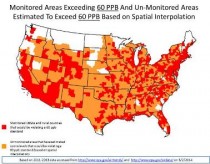
Emissions Map. See impact on jobs and economy by state of the new regulations in this interactive program.
![]() :
:
See the big ones here on this graph from Hansen’s old group at NASA.
Anthony Watts November 19, 2014
![]()
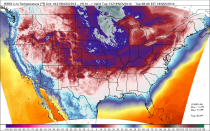
Enlarged
Brisk northwesterly winds in the Great Lakes will cause heavy lake effect snow which will be measured in feet from Michigan to New York state. Monday, over half (50.1%) of the Lower-48 was blanketed in snow. The normal for Christmas is just 33%. Please visit Mashable and Washington Post Capital Weather Gang for daily updates. This is said to be three times the previous November record.
John Kerry ‘Grubering’ about climate change at the start of the Socialist organized Climate Week in Septermber.
Ending the antiquated ban on oil exports will also spur US production and keep oil prices low
Paul Driessen
My only nit-pick was John’s statement early in the interview that “climate change doesn’t exist.” Of course it does....it’s “man-made global warming” or “catastrophic climate change” that don’t exist, haven’t been proven, or aren’t a problem we need to devote billions (or trillions) of dollars addressing. But nobody performs with 100% perfection in front of a camera, and John was amazingly good, the perfect spokesperson for our cause.
John was followed by a much shorter interview with the current CEO of the Weather Channel who was surprisingly (perhaps) low-key, did not attack John, and made little attempt to argue the science.
Congratulations, John! Let’s work to make sure millions of people see this clip.
On Monday, he was seen by two million viewers on “The Kelly File” with Megyn Kelly on the Fox News Channel. Later that night, Coleman was a guest on “Coast to Coast AM,” which for decades has been the most popular overnight radio program in North America with three million listeners.
So tune in to CNN at 11 a.m. ET on Sunday, Nov. 2 to watch Coleman on “Reliable Sources” talk about the media’s complicity in perpetuating an unscientific panic about man’s influence on the climate. Coleman tells us the conversation (taped on Friday for broadcast Sunday morning) focused on The Weather Channel’s response to Coleman’s Monday appearance on “The Kelly File.”
Coleman says the host “didn’t know what hit him,” and, “I assure you, this is not your average TV interview.”
Don’t miss it! Watch CNN’s “Reliable Sources” on Sunday morning.
HLN Weekly
